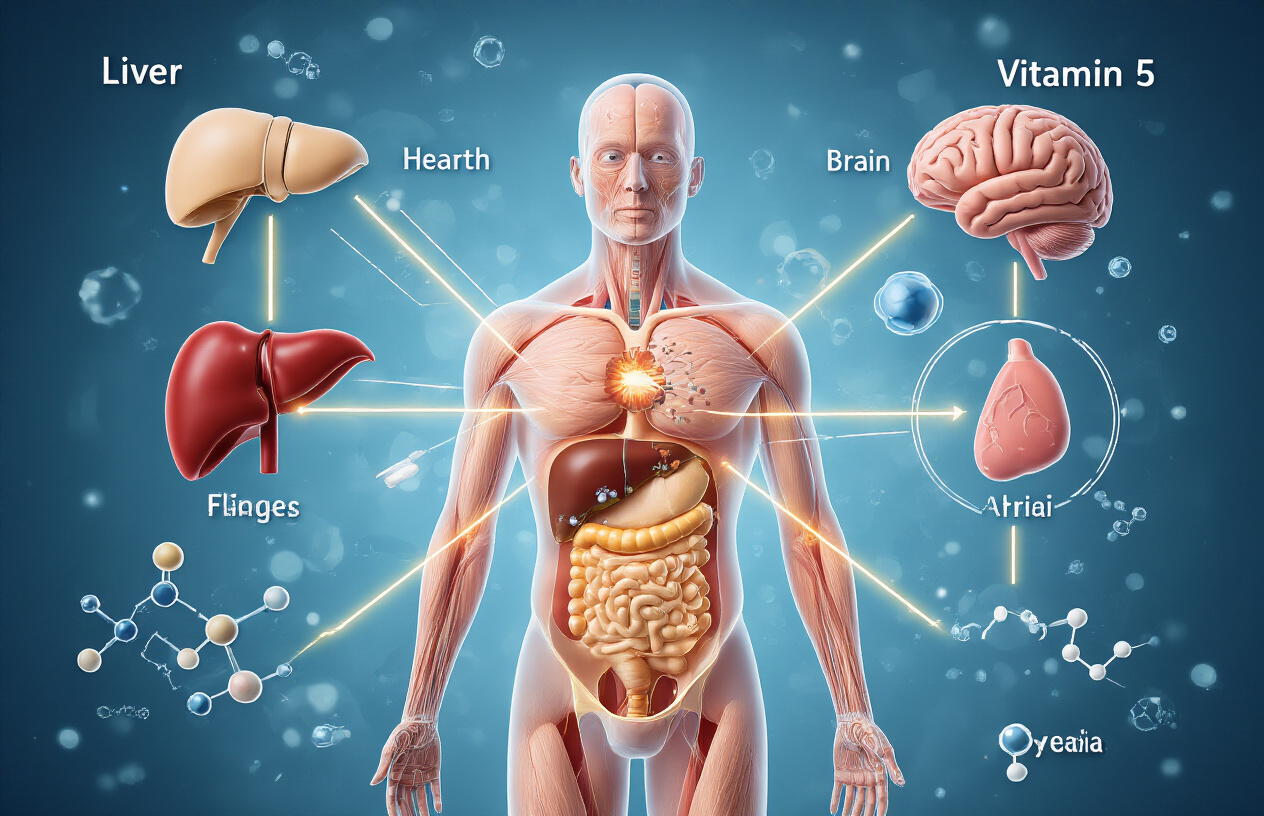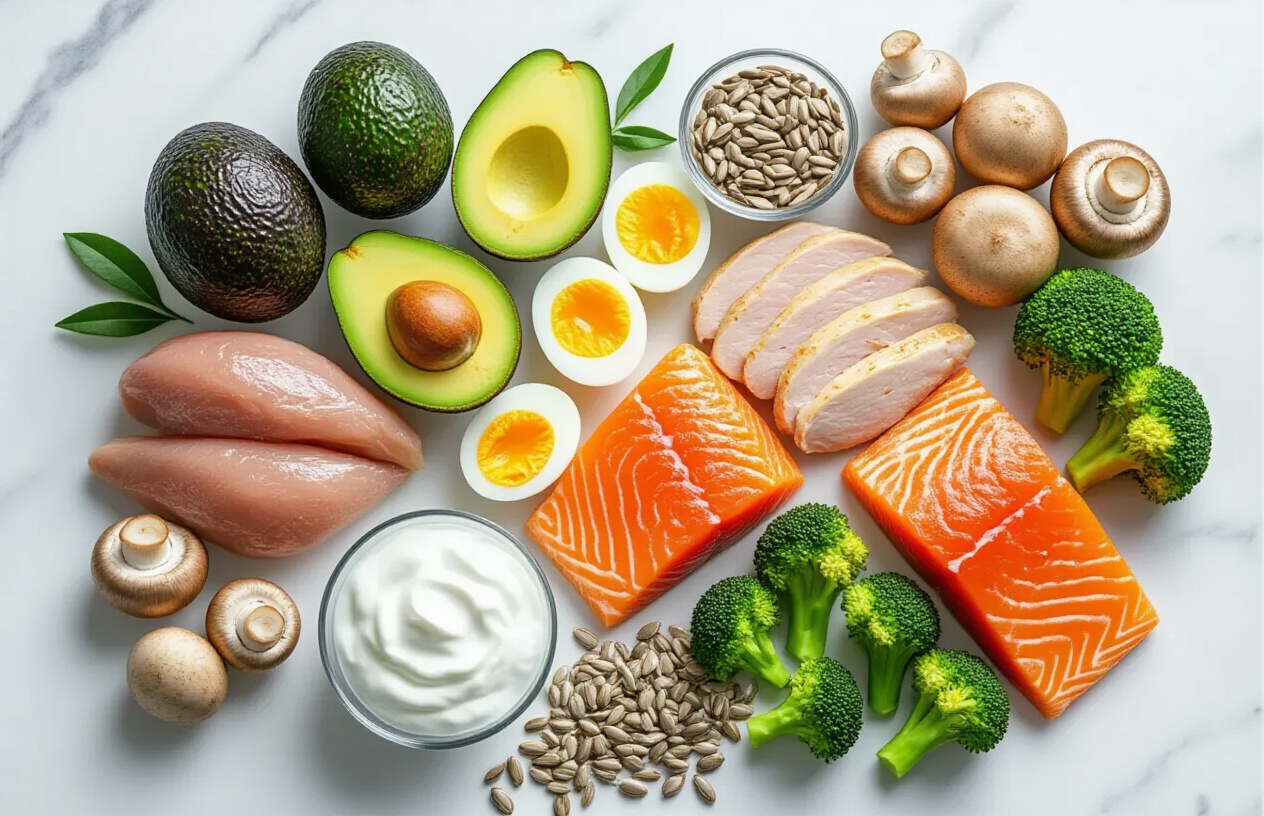Vitamin B5, also known as pantothenic acid, plays a crucial role in converting food into energy and supporting your body’s basic functions. This essential nutrient often flies under the radar compared to other B vitamins, yet it impacts everything from your metabolism to your skin health.
This guide is perfect for health-conscious individuals, fitness enthusiasts, and anyone looking to optimize their nutrition through better understanding of this vital vitamin. You’ll discover how pantothenic acid works in your body and why getting enough matters for your daily energy levels.
We’ll explore the science-backed health benefits that show how vitamin B5 supports your metabolism, hormone production, and overall wellbeing. You’ll also learn to spot the warning signs of deficiency before they affect your health, plus get practical advice on the best food sources and smart supplementation approaches to meet your body’s needs.
Understanding Pantothenic Acid’s Essential Role in Your Body

What Makes Vitamin B5 Crucial for Cellular Function
Pantothenic acid serves as the building block for coenzyme A (CoA), one of the most critical molecules in your cellular machinery. Without this coenzyme, your cells would grind to a halt like a car without oil. CoA acts as a molecular taxi service, shuttling acetyl groups around your cells to power essential biochemical reactions.
Your cells depend on vitamin B5 for:
- Fat synthesis and breakdown – Creating hormones, cell membranes, and energy storage
- Carbohydrate metabolism – Converting sugars into usable energy
- Protein processing – Building and maintaining muscle tissue
- Neurotransmitter production – Supporting brain communication
- Cholesterol synthesis – Producing vital steroid hormones like cortisol and testosterone
Every single cell in your body contains CoA, making pantothenic acid literally essential for life. Your liver, adrenal glands, and nervous system have particularly high concentrations because these tissues work overtime managing metabolism and stress responses.
How Your Body Processes and Utilizes Pantothenic Acid
Your digestive system breaks down pantothenic acid from food sources through a sophisticated absorption process in your small intestine. Once absorbed, your body immediately gets to work converting it into CoA through a five-step enzymatic process that happens primarily in your liver.
Here’s the fascinating journey pantothenic acid takes through your system:
| Processing Stage | Location | Function |
|---|---|---|
| Absorption | Small intestine | Uptake into bloodstream |
| Transport | Blood circulation | Delivery to cells |
| Conversion | Cellular level | Transformation to CoA |
| Utilization | All tissues | Energy production and metabolism |
Your kidneys play a major role in maintaining optimal B5 levels by filtering excess amounts and reabsorbing what your body needs. This recycling system helps prevent wastage, though your body still can’t store significant amounts for later use.
The Connection Between B5 and Energy Production
Think of pantothenic acid as the spark plug in your body’s energy engine. Without adequate B5, your cells struggle to extract energy from the food you eat. The vitamin powers the citric acid cycle (also called the Krebs cycle), where your cells convert fats, carbohydrates, and proteins into ATP – your body’s primary energy currency.
When you eat a meal, here’s how B5 helps turn that food into energy:
- Step 1: CoA helps break down fatty acids through beta-oxidation
- Step 2: Carbohydrates get converted to acetyl-CoA for energy production
- Step 3: Proteins are processed into amino acids that feed into energy pathways
- Step 4: All these pathways converge in the mitochondria to produce ATP
Athletes and physically active people often notice the difference when their B5 levels are optimal – better endurance, faster recovery, and sustained energy throughout workouts. Your brain also depends heavily on this energy production system, which explains why B5 deficiency can lead to mental fatigue and poor concentration.
Why Your Body Cannot Store This Vital Nutrient
Unlike fat-soluble vitamins that your body can stockpile in fatty tissues, pantothenic acid is water-soluble and gets flushed out regularly through your urine. Your body treats B5 like a daily newspaper – it uses what it needs and discards the rest within 24-48 hours.
This storage limitation means several important things for your health:
- Daily intake matters – You need consistent replenishment from food or supplements
- Stress depletes reserves quickly – Physical or emotional stress burns through B5 faster
- Cooking reduces availability – Heat and processing destroy much of the vitamin in foods
- Alcohol interferes with absorption – Regular drinking can create functional deficiencies
Your body’s inability to store pantothenic acid explains why deficiency symptoms can appear relatively quickly during times of increased need or poor dietary intake. Pregnant women, people under chronic stress, and those with digestive disorders face higher risks of running low on this essential nutrient.
The water-soluble nature also means you’re unlikely to experience toxicity from B5, as excess amounts get eliminated naturally. However, this same characteristic makes consistent daily intake absolutely crucial for maintaining optimal cellular function and energy production.
Science-Backed Health Benefits That Transform Your Wellbeing

Boost Your Energy Levels and Combat Fatigue
Pantothenic acid serves as the backbone of your body’s energy production system by forming coenzyme A, a critical compound that transforms the food you eat into usable cellular energy. When your B5 levels are optimal, your mitochondria work like well-oiled machines, efficiently converting carbohydrates, fats, and proteins into ATP – the currency your cells use for every function from muscle contraction to brain activity.
Research shows that people with adequate pantothenic acid levels experience more sustained energy throughout the day, avoiding the dreaded afternoon crash that sends many reaching for caffeine or sugar. Your adrenal glands particularly rely on B5 to produce stress hormones like cortisol, which help regulate your body’s response to physical and mental demands. When these glands function properly, you maintain steady energy levels even during challenging periods.
Athletes and fitness enthusiasts often notice improved endurance when their B5 intake is sufficient. A study published in the International Journal of Sports Medicine found that pantothenic acid supplementation helped reduce exercise-induced fatigue and improved recovery times. Your muscles can work harder for longer periods because the cellular energy production runs more smoothly, like upgrading from a sluggish old engine to a high-performance motor.
Support Healthy Skin and Accelerate Wound Healing
Your skin cells regenerate constantly, and pantothenic acid plays a starring role in this renewal process. B5 helps synthesize lipids that form your skin’s protective barrier, keeping moisture in and harmful bacteria out. When this barrier functions well, your skin appears plump, hydrated, and resilient against environmental stressors like pollution and UV damage.
Clinical trials have demonstrated pantothenic acid’s impressive wound-healing properties. Topical applications of B5 can speed up the healing process by promoting collagen synthesis and reducing inflammation. Your body uses pantothenic acid to create new tissue more efficiently, which explains why many dermatologists recommend it for treating minor cuts, scrapes, and even acne lesions.
The anti-inflammatory effects of B5 extend beyond wound healing to general skin health. People with conditions like eczema or dermatitis often experience improvement when their pantothenic acid levels are optimized. Your skin produces less inflammatory compounds and maintains better overall balance, resulting in a clearer, more even complexion that looks naturally radiant.
Enhance Your Mental Clarity and Cognitive Function
Your brain consumes about 20% of your body’s total energy, making pantothenic acid essential for optimal cognitive performance. B5 supports the production of acetylcholine, a neurotransmitter crucial for memory formation, learning, and attention. When your brain has adequate B5, neural pathways communicate more effectively, leading to sharper focus and improved mental processing speed.
Studies have linked sufficient pantothenic acid levels to better stress management and emotional regulation. Your brain produces neurotransmitters more efficiently when B5 is available, helping maintain stable moods and reducing anxiety. Many people report feeling more mentally resilient and better able to handle challenging situations when their B5 status is optimal.
Memory consolidation also benefits from adequate pantothenic acid intake. Research suggests that B5 helps strengthen the connections between neurons, making it easier to form new memories and recall stored information. Students and professionals often notice improved concentration and reduced mental fatigue when their diet includes plenty of B5-rich foods or appropriate supplementation.
Recognizing Deficiency Signs Before They Impact Your Health

Early Warning Symptoms You Should Never Ignore
Your body sends clear signals when pantothenic acid levels drop below optimal ranges. Fatigue hits first – not the regular end-of-day tiredness, but a deep exhaustion that rest doesn’t fix. You might notice your usual morning energy never quite arrives, or that afternoon slumps become deeper and longer.
Digestive issues often follow close behind. Stomach discomfort, nausea, and changes in appetite can signal dropping B5 levels. Your skin may become more sensitive, developing irritation or unusual dryness that doesn’t respond to typical moisturizers.
Sleep patterns frequently shift when deficiency develops. You might fall asleep easily but wake up feeling unrefreshed, or find yourself tossing and turning despite feeling exhausted. Mood changes become noticeable too – irritability, anxiety, or feeling overwhelmed by normally manageable situations.
Muscle cramps and weakness in your legs and arms can develop, particularly during physical activity. Your immune system may struggle, leaving you catching every cold that goes around your office or feeling like minor illnesses linger longer than usual.
Who Faces Higher Risk of B5 Deficiency
Certain groups need to pay extra attention to their pantothenic acid intake. People following extremely restrictive diets face elevated risk, especially those eliminating entire food groups without proper nutritional planning. Crash dieters and those consuming fewer than 1,200 calories daily often fall short of essential B-vitamin requirements.
Chronic stress creates higher B5 demands throughout your body. If you’re dealing with ongoing work pressure, family challenges, or health issues, your pantothenic acid needs increase significantly. Your adrenal glands burn through B5 rapidly during stressful periods, potentially creating deficiency even with adequate dietary intake.
Alcoholism severely impacts B-vitamin absorption and storage. Regular heavy drinking interferes with your body’s ability to process and retain pantothenic acid, creating deficiency despite normal dietary intake.
Pregnant and breastfeeding women require substantially more B5 to support both their own health and their baby’s development. Age also plays a role – older adults often absorb nutrients less efficiently and may have dietary limitations that reduce B5 intake.
People with digestive conditions like Crohn’s disease, celiac disease, or chronic diarrhea struggle to absorb B-vitamins properly, regardless of dietary intake levels.
How Deficiency Affects Your Daily Performance
When pantothenic acid levels drop, your energy production systems start failing. Simple tasks that used to feel effortless suddenly require conscious effort. Climbing stairs leaves you breathless, carrying groceries feels heavier, and mental tasks that once came naturally now demand significant concentration.
Your cognitive performance takes a noticeable hit. Memory lapses become frequent – forgetting names, misplacing keys, or losing track of conversations mid-sentence. Decision-making becomes harder, and you might find yourself staring at restaurant menus or email responses longer than usual, unable to choose or focus.
Physical coordination suffers as B5 deficiency progresses. Your hands might feel less steady, making activities like writing, typing, or cooking more challenging. Balance issues can develop, making you feel unsteady on your feet or dizzy when standing up quickly.
Work performance inevitably declines. Projects that normally take an hour stretch into several. Creative thinking feels blocked, and problem-solving abilities diminish. Social interactions become draining rather than energizing, and you might find yourself avoiding activities you previously enjoyed.
Sleep quality deteriorates, creating a vicious cycle. Poor sleep worsens deficiency symptoms, while deficiency makes restful sleep harder to achieve.
Long-term Health Consequences of Inadequate Intake
Prolonged pantothenic acid deficiency creates serious health complications that extend far beyond simple fatigue. Your adrenal glands suffer significant damage when forced to operate without adequate B5 support. This leads to adrenal insufficiency, where your body loses its ability to respond appropriately to stress, regulate blood pressure, or maintain stable energy levels throughout the day.
Neurological problems develop over time, including peripheral neuropathy – a condition causing numbness, tingling, and burning sensations in your hands and feet. These symptoms often start mild but can progress to significant pain and mobility issues if deficiency continues untreated.
Your immune system weakens substantially with chronic B5 inadequacy. You become susceptible to frequent infections, and minor illnesses turn into major health events. Wound healing slows dramatically, and your body struggles to recover from injuries or surgical procedures.
Digestive health deteriorates as stomach acid production decreases and intestinal function declines. This creates malabsorption issues that worsen nutritional deficiencies across multiple vitamins and minerals, creating a cascade of health problems.
Cardiovascular risks increase as cholesterol metabolism becomes impaired. Your body loses its ability to maintain healthy cholesterol levels, potentially contributing to heart disease development. Skin health suffers long-term damage, with premature aging, persistent acne, and slow healing becoming permanent issues without adequate B5 restoration.
Top Food Sources to Maximize Your Pantothenic Acid Intake

Animal-Based Foods Rich in Bioavailable B5
Animal proteins deliver some of the highest concentrations of pantothenic acid in forms your body can easily absorb. Beef liver tops the list with approximately 7.2 mg per 100 grams, making it the ultimate B5 powerhouse. Chicken liver follows closely with 6.2 mg per serving, while beef kidney provides about 3.8 mg.
For those who prefer more common cuts, lean beef contains around 0.5-0.8 mg per 100 grams, and chicken breast offers about 0.7 mg. Fish lovers can count on salmon, which provides roughly 1.6 mg per serving, while tuna delivers about 1.0 mg. Eggs are particularly valuable since they’re consumed regularly – one large egg contains approximately 0.7 mg of B5.
Dairy products also contribute meaningful amounts. Greek yogurt provides about 0.4 mg per cup, while milk contains roughly 0.3 mg per 8-ounce glass. These foods offer the added benefit of complete protein profiles alongside their B5 content.
| Food Source | B5 Content (mg per 100g) | Daily Value % |
|---|---|---|
| Beef Liver | 7.2 | 144% |
| Chicken Liver | 6.2 | 124% |
| Salmon | 1.6 | 32% |
| Chicken Breast | 0.7 | 14% |
| Eggs (2 large) | 1.4 | 28% |
Plant-Based Options for Vegetarians and Vegans
Plant foods can absolutely meet your B5 needs with smart choices. Mushrooms stand out as exceptional sources – shiitake mushrooms contain about 3.6 mg per cup, while cremini and portobello varieties provide around 2.5 mg per cup. This makes mushrooms one of the richest plant sources available.
Avocados deserve special recognition, offering approximately 1.4 mg per medium fruit along with healthy fats that support nutrient absorption. Sweet potatoes provide about 0.9 mg per large potato, plus they’re loaded with beta-carotene and fiber.
Legumes are reliable B5 contributors that fit perfectly into plant-based meal planning. Split peas lead with 1.3 mg per cooked cup, followed by lentils at 1.3 mg and black-eyed peas at 1.2 mg per cup. These protein-rich foods make excellent foundation ingredients for satisfying meals.
Whole grains shouldn’t be overlooked. Brown rice contains about 0.6 mg per cup, while fortified cereals can provide varying amounts depending on the brand. Sunflower seeds pack 2.4 mg per quarter-cup serving, making them perfect for snacking or adding to salads and smoothie bowls.
Broccoli offers 0.5 mg per cup along with vitamin C, which may enhance B5 absorption. Even leafy greens like spinach contribute modest amounts while providing numerous other essential nutrients.
Surprising Everyday Foods That Boost Your B5 Levels
Your pantry likely contains several B5 sources you never considered. Peanut butter provides about 0.5 mg per two-tablespoon serving – perfect for morning toast or smoothie additions. Regular potatoes, often dismissed as nutritionally empty, actually contain 0.5 mg per medium potato with skin.
Milk chocolate surprisingly contains about 0.4 mg per ounce, though dark chocolate varieties typically offer even more. While you shouldn’t rely on chocolate as your primary B5 source, it’s nice knowing your occasional treat contributes to your nutrient intake.
Corn on the cob delivers 0.8 mg per large ear, making summer barbecues a bit more nutritious. Tomatoes provide modest amounts too – about 0.3 mg per cup of cherry tomatoes, which adds up when you eat them regularly in salads or as snacks.
Even your morning coffee contributes trace amounts of B5, and if you add milk, you’re boosting that content slightly. Bananas contain about 0.3 mg each, making them convenient portable B5 sources that pair perfectly with peanut butter for a nutrient combo.
Bread made from whole grains typically contains 0.2-0.4 mg per slice, depending on the grain blend used. This means your daily sandwich habit actually supports your B5 intake, especially when combined with B5-rich fillings like chicken, eggs, or avocado.
The key lies in eating a varied diet that includes multiple B5 sources throughout your day rather than depending on single superfoods to meet your needs.
Smart Supplementation Strategies for Optimal Results

When to Consider B5 Supplements Over Food Sources
Most people get enough pantothenic acid from their regular diet without thinking twice about it. Whole foods like eggs, chicken, avocados, and mushrooms naturally pack this vitamin, making deficiency pretty rare in healthy adults. But there are times when popping a supplement makes more sense than just relying on your meals.
People dealing with chronic stress often burn through B5 faster than usual. Your adrenal glands work overtime during stressful periods, and they need extra pantothenic acid to keep producing stress hormones. Athletes and people with physically demanding jobs might also find themselves needing more than food alone can provide.
Digestive issues throw another wrench into the mix. If you have celiac disease, Crohn’s, or other conditions that mess with nutrient absorption, you might not be getting all the B5 your body needs from food. The same goes for people on restricted diets – vegans sometimes struggle to hit optimal levels since animal products tend to be the richest sources.
Certain medications can also drain your B5 stores. Birth control pills, some antibiotics, and acid-blocking medications can interfere with how your body processes and uses this vitamin. If you’re taking any of these long-term, a supplement might help fill the gaps.
Choosing the Right Dosage for Your Individual Needs
The recommended daily amount sits at 5mg for adults, but real life isn’t always that simple. Your personal needs depend on several factors, including your stress levels, activity level, and overall health status.
For general health maintenance, most people do well with 10-25mg daily. This covers your basic needs while providing a small buffer for times when your body demands more. If you’re dealing with high stress or recovering from illness, bumping up to 50-100mg often makes sense.
| Life Stage/Condition | Suggested Daily Dose |
|---|---|
| General maintenance | 10-25mg |
| High stress periods | 50-100mg |
| Athletic training | 25-75mg |
| Wound healing | 50-200mg |
| Acne treatment | 1,000-2,000mg |
Some people use much higher doses for specific health concerns. Acne treatment protocols sometimes call for 1,000-2,000mg daily, though you should definitely work with a healthcare provider at these levels. Starting low and gradually increasing helps you figure out what your body responds to best.
Your age matters too. Older adults often need slightly more B5 since absorption tends to decrease over time. Pregnant and breastfeeding women also have higher needs to support both their own health and their baby’s development.
Potential Side Effects and Safety Considerations
Pantothenic acid has earned a reputation as one of the safer B vitamins, and for good reason. Your body doesn’t store much of it, so excess amounts just get flushed out through urine. Most people can take moderate doses without any problems whatsoever.
That said, going overboard with really high doses can sometimes cause issues. Some people report stomach upset, nausea, or diarrhea when taking several grams daily. These side effects usually clear up once you dial back the dose or take the supplement with food.
Very high doses – we’re talking 10+ grams per day – have occasionally caused more serious digestive problems in sensitive individuals. Sticking to reasonable amounts keeps you in the safe zone while still getting the benefits you’re after.
Drug interactions are minimal compared to other supplements. B5 doesn’t seem to interfere with most medications, though it might slightly enhance the effects of other B vitamins when taken together. This synergy is usually a good thing rather than a concern.
People with kidney problems should check with their doctor before taking large amounts of any water-soluble vitamin, including B5. While toxicity is rare, your kidneys still need to process and eliminate the excess.
How to Enhance Absorption and Maximize Benefits
Getting the most bang for your buck from B5 supplements comes down to timing and smart combinations. Unlike fat-soluble vitamins, pantothenic acid dissolves in water, which means you don’t need to take it with fats or oils for absorption.
Taking your supplement with food helps reduce any chance of stomach irritation while supporting steady absorption. Your digestive system handles B vitamins better when there’s other food around to slow down the process.
The other B vitamins work as a team, so taking a B-complex rather than isolated B5 often gives better results. B1, B2, B3, B6, and B12 all support each other’s functions in your body’s biochemical processes. When one B vitamin is missing or low, the others can’t do their jobs as effectively.
Vitamin C also plays a supporting role in B5 absorption and utilization. If you’re taking separate supplements, spacing them throughout the day rather than all at once helps maintain steady blood levels.
Avoiding certain substances around supplement time makes a difference too. Coffee, tea, and alcohol can interfere with B vitamin absorption when consumed at the same time. Try to leave at least an hour between your supplement and these drinks.
Timing Your Supplements for Peak Effectiveness
When you take B5 can be just as important as how much you take. Since this vitamin plays a key role in energy production, many people find morning dosing works best. Taking it early in the day supports natural energy rhythms without interfering with sleep.
If you’re splitting your dose throughout the day, morning and early afternoon work well. Taking B vitamins too late in the evening sometimes keeps people wired when they’re trying to wind down for bed.
During stressful periods, you might benefit from taking smaller amounts more frequently rather than one large dose. Your adrenal glands use B5 continuously during stress, so keeping steady levels in your system provides better support.
For people using B5 to help with acne or wound healing, consistency matters more than specific timing. Taking your dose at the same time each day helps maintain steady tissue levels where the healing work happens.
Exercise timing creates another consideration. Taking B vitamins before workouts can support energy production, but some people find they perform better when they take them afterward instead. This helps with recovery and prevents any potential stomach upset during intense activity.

Vitamin B5 might not get as much attention as other B vitamins, but it’s quietly working behind the scenes to keep your body running smoothly. From converting food into energy to supporting healthy skin and managing stress hormones, pantothenic acid plays a vital role in your daily health. The good news is that deficiency is rare since this vitamin shows up in so many foods we already eat.
Start paying attention to the foods on your plate – eggs, avocados, mushrooms, and whole grains are all excellent sources that can easily fit into your regular meals. If you’re dealing with chronic stress, skin issues, or constant fatigue, consider talking to your healthcare provider about whether you’re getting enough B5. Your body deserves all the support it can get, and making sure you have adequate pantothenic acid levels is one simple way to help it thrive.














